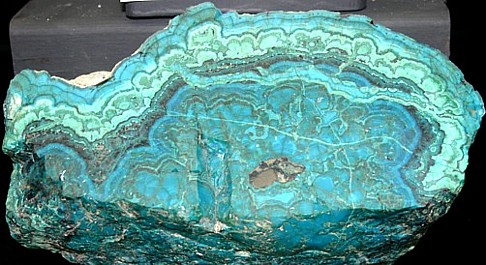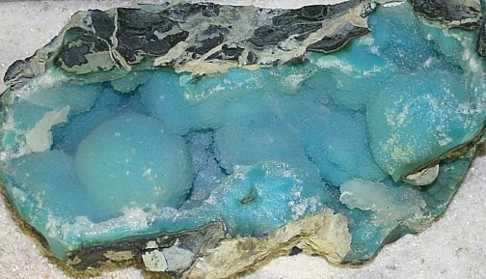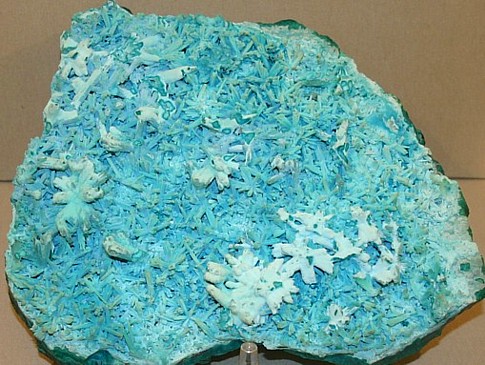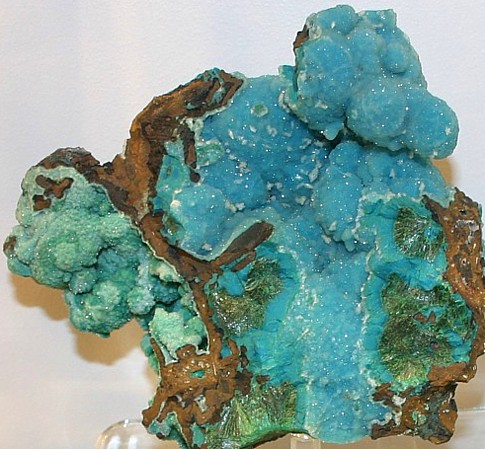|
.
Chrysocolla
Mineral Facts:
Chemical
Formula: CuSiO3(H2O)2
Hydrated Copper silicate. Copper
oxide 45% but varies considerably in composition and often impure.
Colors:
Shades of blue to greenish blue
(turquoise)
Streak is white to pale green.
Hardness: 2 to 4
(harder with excess silica)
Hardness varies - porous earthy forms
are softer.
Density:
2 to 2.4
Cleavage:
None known. rough
and uneven
concoidal fracture
: brittle.
Crystallography:
Unknown - Microcrystalline
Massive compact.
Sometimes earthy. Usually occurs in encrustations or in thin seams ;
botryoidal and massive, with a compact and enamel-like texture.
Luster:.
Earthy to Vitreous, transparent to translucent - on rare
occasions it is
used as a gemstone.
Optics: (Refractive Index) = Unknown
|
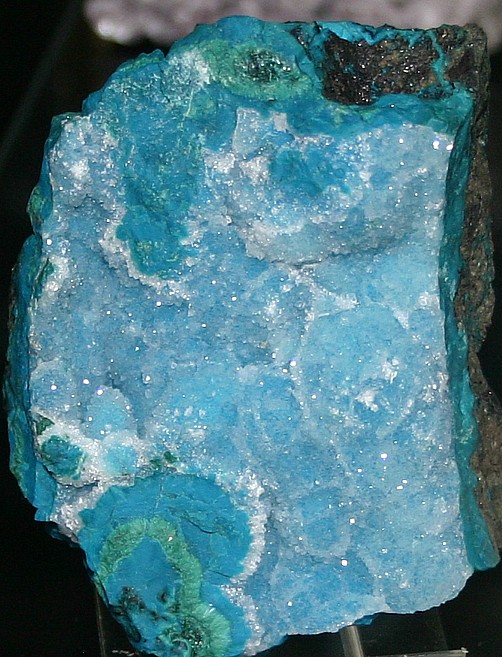 |
. |
Composition, Structure and
Associated Minerals:
Chrysocolla occurs usually in dense masses without any sign of
crystallization; but at several places it has been found in spherulitic
forms that are made up of fibers that are apparently acicular crystals. The
symmetry of these, however, is unknown. The general view is that the mineral
is colloidal. Chrysocolla is produced by the oxidation of copper compounds
and combination of these oxidation products with silicic acid in the upper
portions of ore veins. It sometimes replaces other minerals, as atacamite,
cerussite
and labradorite and forms pseudomorphs after them. It is
associated with
malachite,
azurite,
cuprite,
native copper, and other
secondary copper minerals. It is sometimes considered to contain a variable
amount of free silica, and some specimens which are sufficiently hard to
scratch glass may be cut and polished for jewelry. It is not a common
gemstone as suitable material is rare, but is much appreciated by
collectors.
Identification
and Diagnostics
Is decomposed by acids without
effervescence (which serves to distinguish it from malachite). It is not,
however, completely soluble. It is distinguished from other green and blue
silicates by its reaction toward HC1
and the green flame it
imparts to the blowpipe flame. Decomposed by hydrochloric acid with the
separation of silica but without the formation of a jelly. Gives a copper
globule when fused with sodium carbonate on charcoal.With the fluxes, it
gives the usual copper reactions.
Occurrence,
Localities and Origins:
Occurs in the
zone of weathering zone or gossan of many different copper deposits, and
when found in sufficient quantity, constitutes a copper ore of some value.
It is easily reduced when mixed with limestone. Due to its many impurities
it seldom yields more than 10 per cent copper. Chrysocolla is mined with
other ores of copper and is treated with them for the metal it contains.
Exact statistics of the quantity produced are not obtainable, but overall it
is a
minor ore of copper.
The mineral occurs in
many copper mines
worldwide, especially in Bohemia, Hungary, Italy and Russia. Also in
Cornwall, Saxony, Bavaria, Siberia and South Australia. t is also abundant
in Chile, where it occurs in all varieties.
It occurs at many locations
in the United States, especially as blue crusts on the basalts near
Somerville, N. J.; and as a bluish green matrix cementing black masses at
the Old Dominion Copper Mine, Globe, Ariz; and most of the other copper
mines of Arizona, Nevada and New Mexico. It is found intimately intergrown
with opal at the Boleo Mine, California.
.Return
to the
Mineral Collectors Information Page |
|


